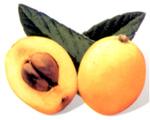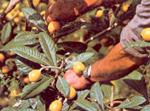| Fruits |
Vegetables
|
Loquat, Eriobotrya japonica / Rosaceae
|
Note: Composition for 100 g. of fresh product Values in ( min. - max. ) format. | |
| Energy: 28-54 kcal Fats: 0.2-1.0 g Fibres: 0.30-2.07 g Minerals Calcium: 16-20 mgZinc: 0.2-0.2 mg Phosporus: 11-23 mg Iron: 0.3-0.4 mg Magnesium: 10-10 mg Manganese: 0.1-0.1 mg Potasium: 220-263 mg Selenium: 0.5-1.0 µg Sodium: 1-4 mg | Proteins: 0.4-0.7 kcal Carbohidrates: 6.3-10.5 g Liposoluble Vitamins A Retinol: 133.3-133.3 µgA Carotenoids: 160-800 µg Liposoluble Vitamins B1 or Thiamine: 0.020-0.045 mgB2 or Riboflavine: 0.030-0.061 mg B3 or Niacine: 0.2-0.4 mg |

The loquat is a rounded fruit of orange colour that is appreciated for its aromatic, sweet and somewhat acid flesh. It is usually eaten raw, although they are also processed to prepare jams, pies or juices. It barely provides the organism with nutrients, although it contains potassium in a significant quantity and some vitamins.
Nutrition and eating
The loquat is a digestive, diuretic and depurative food. Furthermore, it reduces the levels of cholesterol and it is recommended to people suffering from hypertension. The leaves are used in some countries to cure various diseases like diabetes or cough.
The fruit
 The loquat is a rounded fruit of orange colour that is appreciated for its aromatic, sweet and somewhat acid flesh. It is usually eaten raw, although they are also processed to prepare jams, pies or juices. It barely provides the organism with nutrients, although it contains potassium in a significant quantity and some vitamins.
The loquat is a rounded fruit of orange colour that is appreciated for its aromatic, sweet and somewhat acid flesh. It is usually eaten raw, although they are also processed to prepare jams, pies or juices. It barely provides the organism with nutrients, although it contains potassium in a significant quantity and some vitamins.There are two species of loquat, the European and the Japanese, although the most well-known is the latter. It is a rounded or pear-shaped fruit, with a thin and hard skin, of a yellow-orange colour. The pulp is aromatic, of white or orange colour, fleshy and of sweet, somewhat acid taste. It contains several brown seeds of great size.
Loquat are mainly consumed raw, as fresh fruit. They are also used to process sauce, jellies, jams and confectionery products, along with juices or syrups. In some cases they are stewed; in the Bermuda they make a characteristic liquor.
It is low in nutrients and calories, reason why it is recommended in slimming diets. It provides with potassium and small quantities of calcium, phosphorus, magnesium and iron. It also contains small amounts of vitamin B1, B2, B3 and C.
The plant

The loquat tree measures 5-8m high, it is extremely branched and it blooms in autumn, bearing a great number of white flowers grouped at the tips of the branches. These flowers give rise to a very juicy orange fruit of somewhat acid flavour, 6cm long.
The loquat is a plant belonging to the family of Rosaceae, whose scientific name is Eriobotrya japonica. It is a small tree, 5-8m high, with a rounded crown. The trunk is straight and branched at a very low height. The roots are extremely superficial.
The leaves are alternate and hairy, of lanceolate or elliptical shape. They measure between 15 and 20cm long and they have sawed edges.
The flowers are white and small, 1.5cm of diameter. They bear 5 wide petals. They are grouped in great number at the end of the buds, although not all bear fruit and many of them fall.
The fruit has pear-shape and yellow-orange colour, between 2.5 and 6cm of length. The skin is thin and strong and the pulp is white or yellow, juicy and somewhat acid. It contains between 1 and 10 seeds of dark brown colour.
This species blooms in autumn, although in the tropical it may undergo up to three flowerings a year, being the second one of greater yield.
The loquat is a plant belonging to the family of Rosaceae, whose scientific name is Eriobotrya japonica. It is a small tree, 5-8m high, with a rounded crown. The trunk is straight and branched at a very low height. The roots are extremely superficial.
The leaves are alternate and hairy, of lanceolate or elliptical shape. They measure between 15 and 20cm long and they have sawed edges.
The flowers are white and small, 1.5cm of diameter. They bear 5 wide petals. They are grouped in great number at the end of the buds, although not all bear fruit and many of them fall.
The fruit has pear-shape and yellow-orange colour, between 2.5 and 6cm of length. The skin is thin and strong and the pulp is white or yellow, juicy and somewhat acid. It contains between 1 and 10 seeds of dark brown colour.
This species blooms in autumn, although in the tropical it may undergo up to three flowerings a year, being the second one of greater yield.
| Interempresas Media, S.L. / 2026 | [ Legal notice | Política de Protección de Datos | Política de cookies | Publicidad] |
